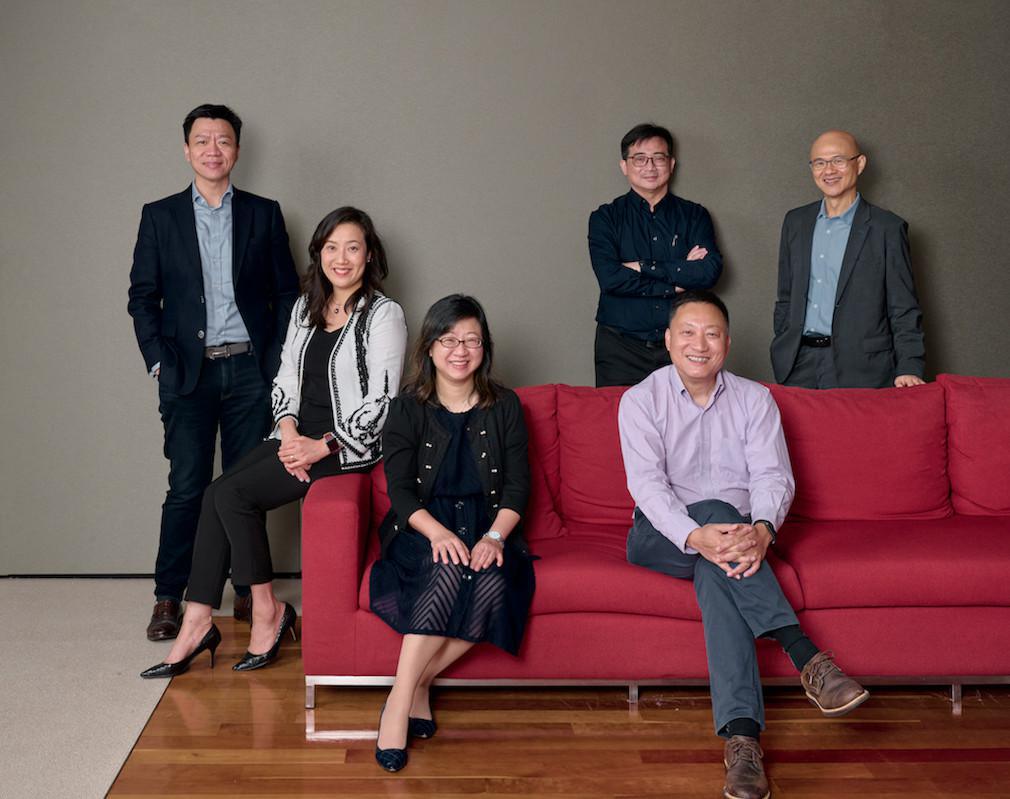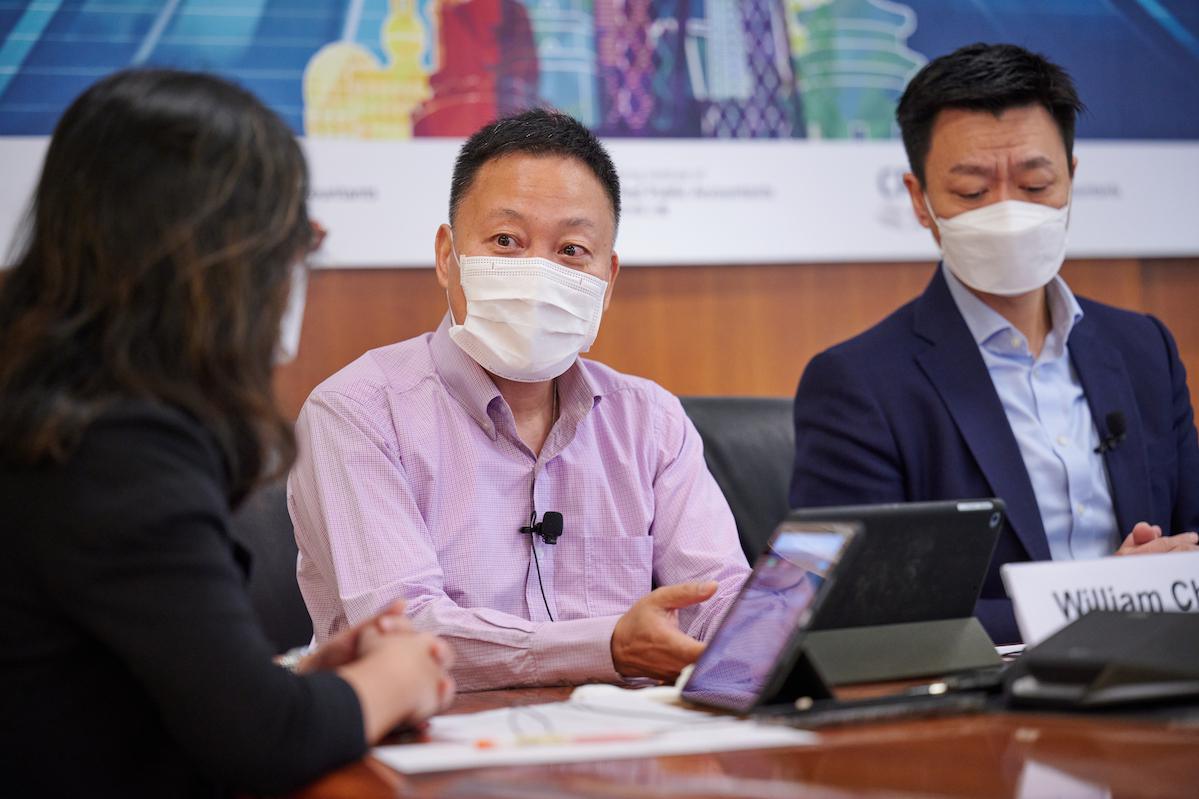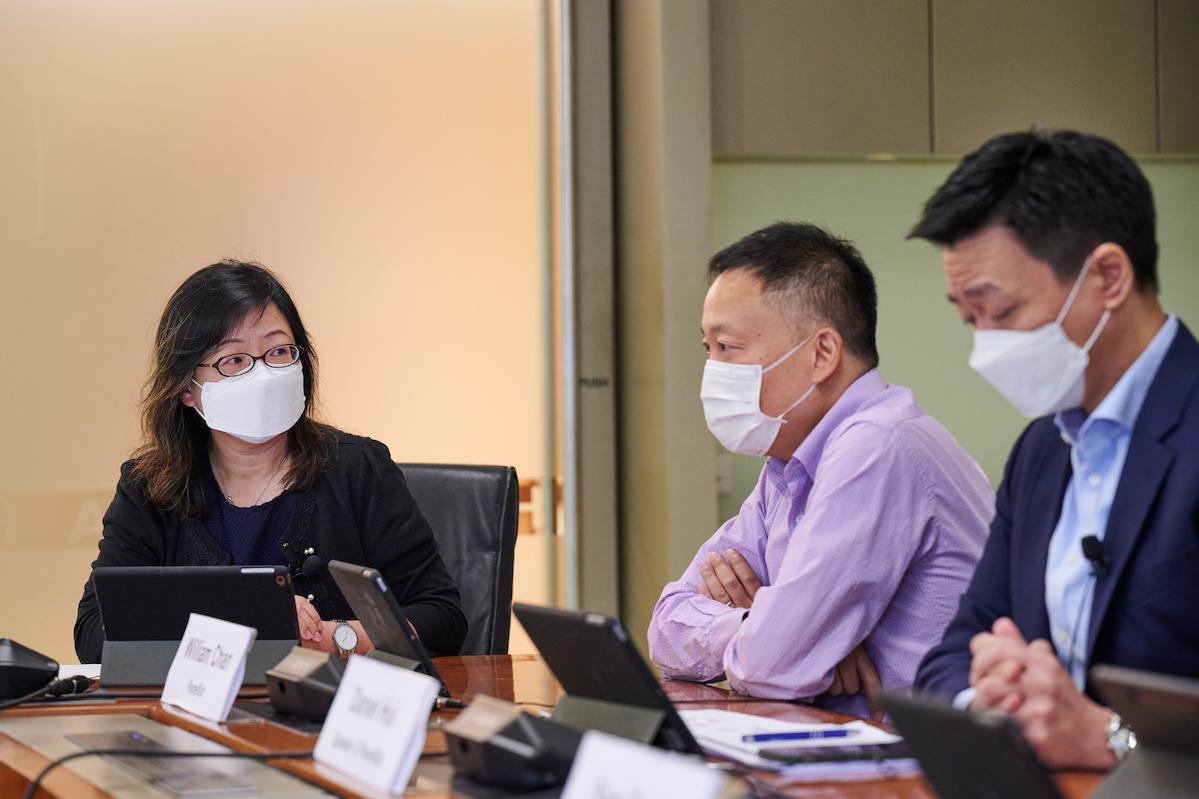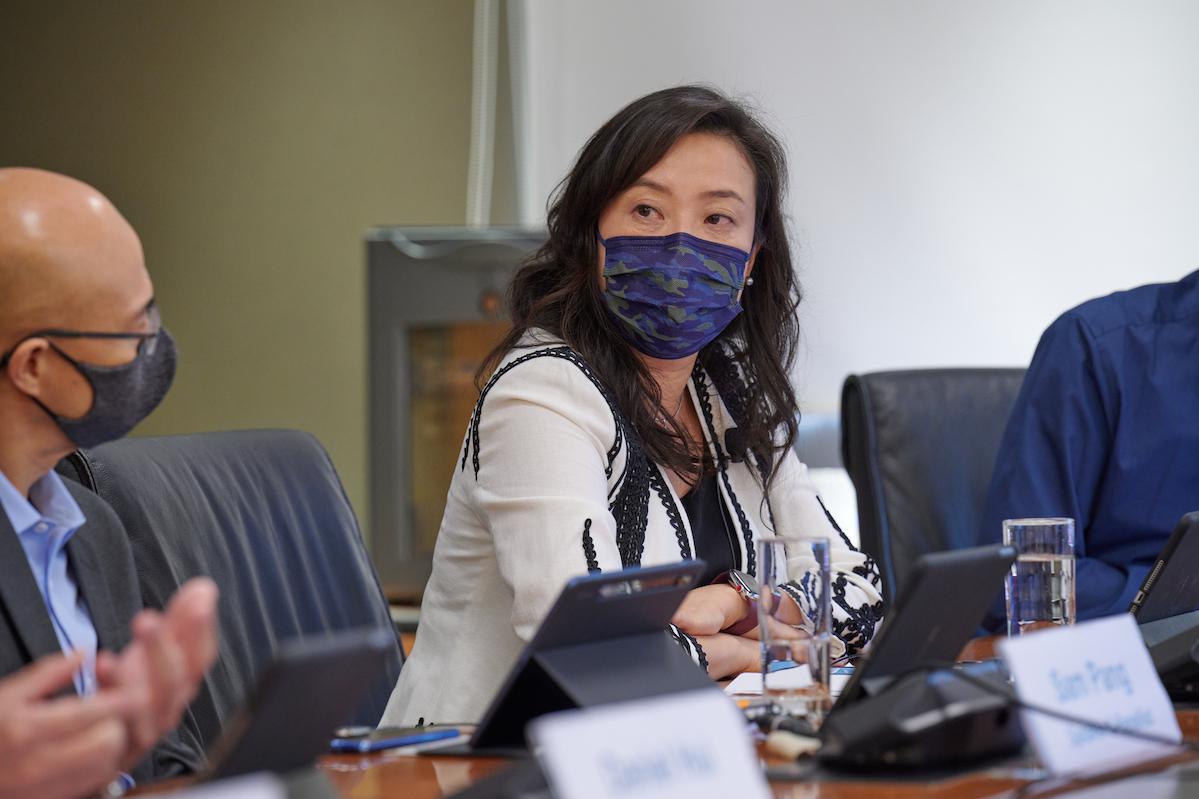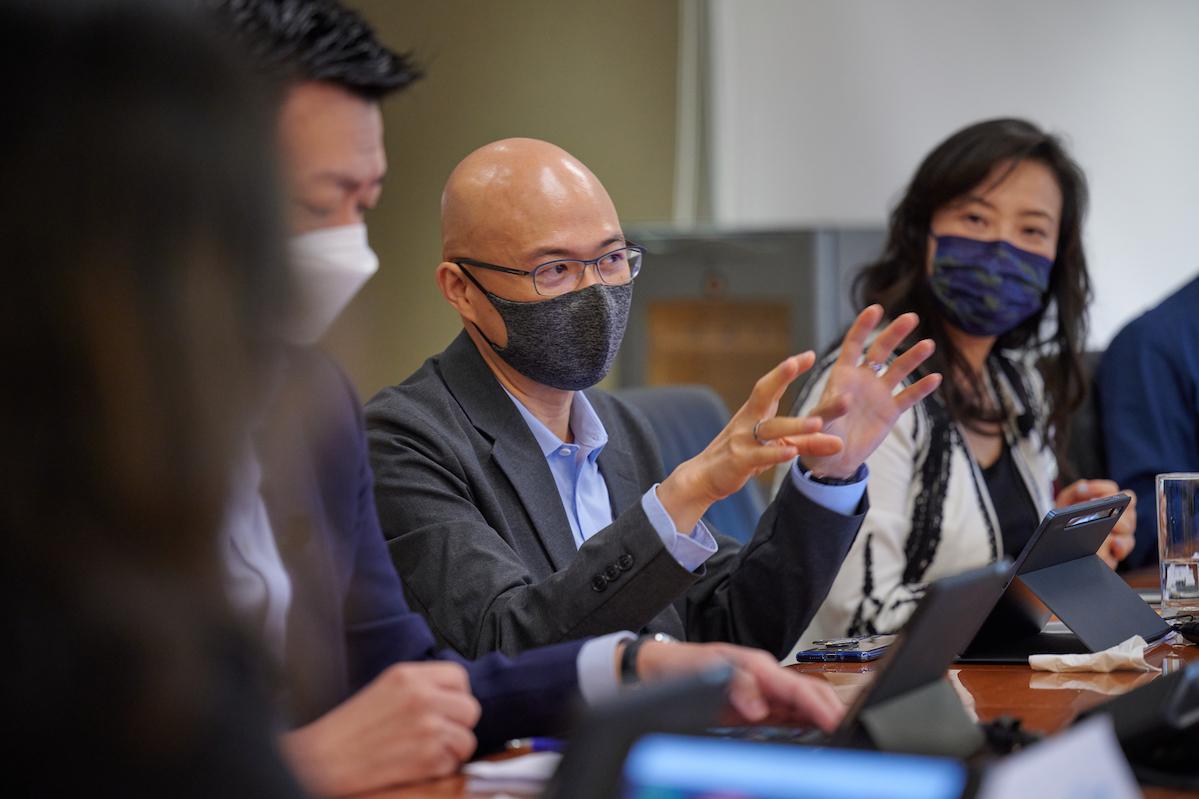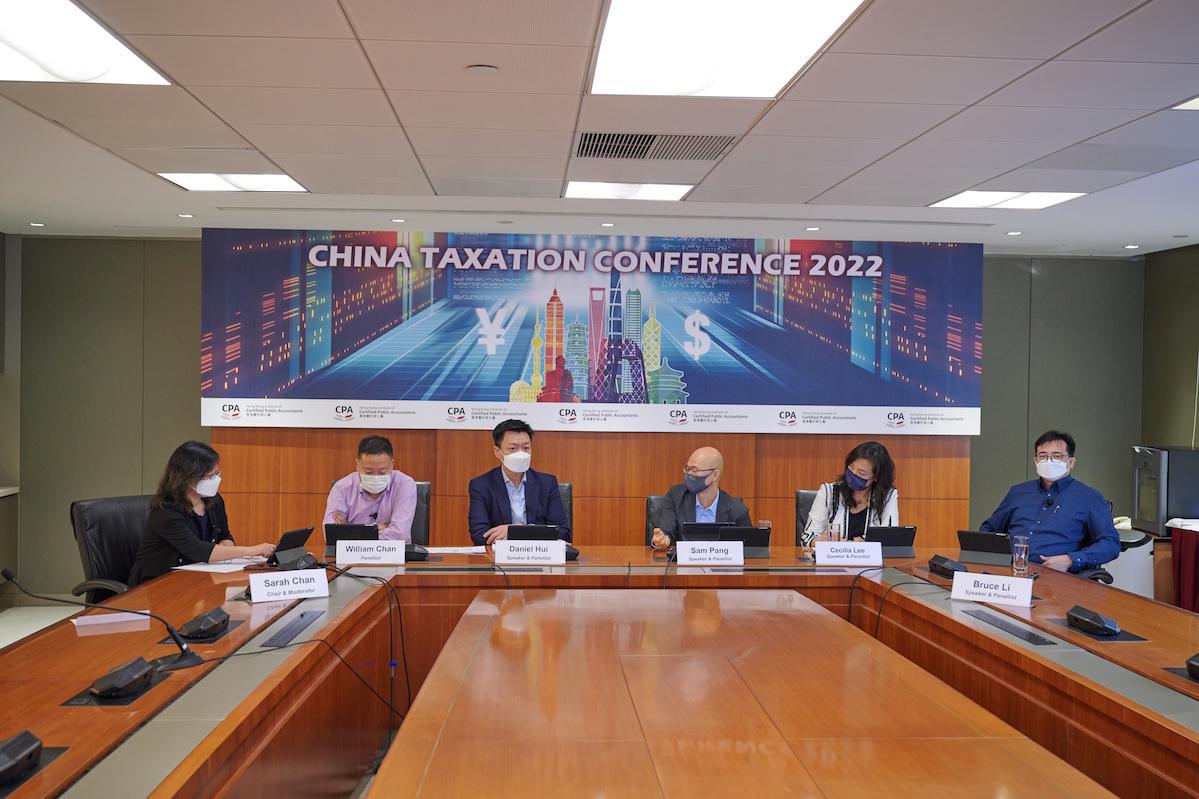When it comes to the latest tax trends in Mainland China, there continues to be many uncertainties and challenges brought about by COVID-19, as well as the evolving state of tax administration. In this environment, companies and individuals need to exercise greater due diligence when it comes to their tax reporting to ensure that they are compliant and remain on the right side of the law. This was one of the key takeaways at the China Taxation Conference 2022, hosted virtually by the Hong Kong Institute of CPAs in May.
Speakers and panellists engaged in a lively discussion over some of the main challenges and opportunities that have emerged as a result of Mainland China’s efforts to develop its taxation system. Some of the key themes included the latest tax relief measures and the intensifying crackdown on tax fraud.
Speakers: (from left) Daniel Hui, Partner of China Tax at KPMG Tax Services, and a member of the Taxation Faculty China Tax Sub-Committee (CTSC); Cecilia Lee, Partner, Tax Services and Transfer Pricing Services at PwC, and a member of the CTSC; Sarah Chan FCPA, Partner, Tax and Business Advisory Services, Deloitte China, Chair of the Taxation Faculty Executive Committee (TFEC), and Convenor of the CTSC; Bruce Li FCPA, Teaching Fellow from the School of Accounting and Finance, the Hong Kong Polytechnic University, and a member of the TFEC and the CTSC; William Chan CPA, Partner, Grant Thornton Tax Services, and a member of the CTSC; and Sam Pang CPA, Partner for the People Advisory Services at EY (China) Advisory Limited, Shenzhen Branch.
Facilitating the event was moderator Sarah Chan FCPA, Partner, Tax and Business Advisory Services, Deloitte China, Chair of the Taxation Faculty Executive Committee (TFEC), and Convenor of the Taxation Faculty China Tax Sub-Committee (CTSC). She started the conversation by explaining the theme of the conference, and issues that more robust tax administration has posed for taxpayers in Mainland China.
“For taxpayers, whether individuals or businesses, they are facing many more taxation costs today, and there are still many uncertainties because of the pandemic. This is why, beyond sharing the latest updates and notable changes in China tax, we have invited seasoned experts and academics to talk about the real world impact these changes have on companies and individuals. Despite all these challenges, what are the opportunities for us to improve the taxation system?” she asked. “What can businesses and taxpayers expect? What’s coming?”
To answer this question, Bruce Li FCPA, Teaching Fellow from the Hong Kong Polytechnic University’s School of Accounting and Finance, and a member of the TFEC and the CTSC, said that practitioners need to grasp the bigger picture in Mainland China. He noted that the State Council held an emergency meeting on 25 May involving around 100,000 local government officials, with Premier Li Keqiang urging local governments to quickly implement economic stimulus policies to mitigate the economic impact of the lockdowns in cities like Shanghai. Bruce Li emphasized that the sudden announcement of the meeting signals that the Chinese government is earnestly making plans for an economic recovery while juggling the containment measures around the COVID-19 pandemic. Many of the stimulus policies were focused on expanding previous support measures such as tax reliefs, fee reductions and subsidies.
“The government has noticed the downward trends in its data, and they want to send a message before it’s too late,” explained Li. “It is a matter of balancing between costs and benefits. China understands the cost of its current COVID strategy, but it will not keep pumping more money in to solve the problem. The government feels that help can be from the bottom up, too.”
He explained that the Chinese government understands that the pandemic measures have led to growing economic pressures, higher operational costs and disruptions in the supply chain, and this is why it has chosen to release a host of tax relief measures aimed at easing the economic burden on taxpayers, and small and medium enterprises (SMEs). At the same time, the meeting sent a strong message, warning local officials to focus on building up the fundamentals, and not simply rely on the state government for large stimulus packages.
Fellow panellist Daniel Hui, Partner of China Tax at KPMG Tax Services, and a member of the CTSC, said that the current tax relief measures are aimed mainly at SMEs in certain vulnerable industries, in the hope that they will be able to weather the current economic storm. “China is essentially using tax measures to help its people. They don’t want to see these SMEs close down,” he said.
For example, the government has pledged 1.5 trillion yuan of large-scale value-added tax (VAT) rebates to be doled out this year, and it has further issued directives on how to speed up the payments and refunds for certain businesses. The details were published through the 2022 Report on the Work of the Government released in early March.
Hui explained that the VAT rebates will be rolled out to companies that fall under six industries: manufacturing, scientific research and development and technology services, energy production and supply, software and information technology services, ecological protection and environmental governance, as well as transport, logistics, warehouses and postal. The panellists believe that supporting these industries makes sense, as it is in line with the Mainland’s broader goal of shifting the country towards a more service-based economy.
For the same reasons, Mainland China has also been focusing on creating specialized tax zones, Hui explained. Pointing to Hainan Island as an example, he explained that making Hainan Island a free trade port was always part of the government’s strategy to attract more foreign direct investment into the country. “The government wants to encourage foreign investment into these areas including the Greater Bay Area (GBA) as part of the strategic development plan. This has always been their long-term plan. They want to attract modern services and create international service centres, like Hong Kong, for bigger multi-national corporations (MNCs), and to improve the local area,” Hui said.
To that end, the Mainland has already relaxed visa requirements, and loosened restrictions on capital flows and data into these areas. Furthermore, to attract talent, it has reduced the income tax rate for qualifying individuals and companies in areas such as Qianhai, Hengqin and Hainan Island to just 15 percent, which is lower than the rest of the Mainland.
This prompted Sarah Chan to ask the panellists whether they thought it was attractive for MNCs to consider going into these areas, where the bar is set lower to do business in Mainland China. “Wouldn’t it be worth putting your resources into specially-designated areas or particular industries that the government is encouraging?” she asked.
William Chan CPA, Partner at Grant Thornton Tax Services, and a member of the CTSC, commented that there are fewer incentives to take advantage of those specific areas for many MNCs that are also major manufacturers. “Many of these MNCs may already qualify for a 15 percent tax rate under the High and New Technology Enterprise programme, regardless of where they are set up. So for them, they are not locked into a particular geographical location,” he said. “Especially since requirements may vary greatly for each area, making it more or less easy for MNCs to enter them.”
Hui added that, for Hainan, in particular, its duty-free programme has made it an attractive destination for luxury brands, while insurance companies have targeted GBA cities such as Shenzhen, Guangzhou and Foshan to set up their services centres, as an entry point for future business opportunities, as the Cross-boundary Wealth Management Connect Scheme continues to evolve.
Cecilia Lee, Partner, Tax Services and Transfer Pricing Services at PwC, and a member of the CTSC, warned that while it looks like an attractive option, at the end of the day, “if you are a business and you want to go in there, you need to make sure you have sufficient economic substance,” she emphasized, explaining that tax authorities have already put policies in place to identify shell companies with minimal substance.
The discussion then quickly turned to the fact that businesses are not the only entities that will benefit from new tax concessions. Individuals also stand to gain under these expanded provisions.
Sam Pang CPA, Partner for the People Advisory Services at EY (China) Advisory Limited, Shenzhen Branch, pointed to tax exemptions for foreigners as an example. He noted that in order to keep Mainland China competitive in the global talent market, the Ministry of Finance and State Taxation Administration had released Circular No. 43, extending tax exemptions for foreigners’ fringe benefits to the end of 2023. Previously, as from 2022, foreigners working in the country were to lose some tax-free fringe benefits, such as housing rental and children’s education costs.
While this was a welcome move, Pang noted that it also posed certain challenges for tax practitioners who wanted to do tax planning, because now foreigners would wonder if there would be further extensions after the new deadline. “What are the new expectations? How do clients plan beyond the end of the next year? We aren’t able to give definite answers to many of these questions.”
Risks and challenges
To further highlight some of these issues, Sarah Chan presented the panellists with a fictional scenario, where a Hong Kong company in the animation and video gaming industry decided to open several subsidiaries in Mainland China to develop intellectual property, as well as promote and sell their products in the Mainland. She asked the speakers, what were the issues, risks and challenges for the company, the tax authorities, and even for individuals who participated in promotion activities?
In examining the case, the speakers agreed that this was not an unusual set up these days, and that the case highlighted many of the problems that companies are facing when it comes to filing tax returns, or being tax compliant, in the Mainland’s current tax environment, given the ongoing COVID measures.
For starters, Pang lamented that, unlike many other countries, Mainland China hasn’t made any concessions for COVID-19 and there are no special facilities to address any tax problems. “So, a common problem now is that businesses or personnel who are supposed to work in Hong Kong are stuck in China, or the other way round, for more than 90 days because of COVID-related travel restrictions. Whether it’s personal or business tax, there are real effects,” he said.
Pang explained that, depending on whether an employee has been able to go back to Mainland China, or is in Hong Kong working in a China-based job, taxing is complicated for the authorities, too. “In such a scenario, the tax authorities would assess whether a foreigner has duties inside or outside of China by calculating their time apportionment, so as to collect taxes on a pro-rata basis, depending on what is China-sourced income versus what is Hong Kong-sourced income,” he explained.
However, there are still many ways in which things can go wrong. Firstly, when it comes to calculating the time apportionment for people who travel in and out of the Mainland for work, Pang explained that if an employee doesn’t stay in the Mainland for more than 183 days, there is an assumption that they don’t need to pay taxes. However, if their income comes from an employer based in the Mainland, they may be liable to taxes.
Then there’s the salary package, he continued. By breaking up the salary package, companies could structure their employees’ packages so that it isn’t taxable, he explained. But then the real question is: “How many salary packages can be broken down like this? The law only allows this to be done within reason. Well, what is within reason?” Pang said. “With so many ambiguities, mistakes can happen stemming from a misunderstanding or misinterpretation of the rules.”
Vigilance is key
Hui took this opportunity to talk about the importance of corporate vigilance. He advised companies and individuals to be very careful as the trend is now for the tax authorities to continue tightening their supervision of businesses and their operations, especially in special ports like Hainan, which they do not want to become tax havens or locations for shell companies.
“The taxman may have given these concessions now, but industries must be very careful,” Hui said. “The tax filings are now all online and taxpayers’ information is in the system, so in this regard, China is quite advanced in data analytics. They’re looking at your company’s data and doing their analysis, so you need to know how your company is paying taxes in China, and you must be prepared when they come asking questions.”
The panellists agreed that digitalization has accelerated the crackdown on tax fraud, and investigations are becoming much more prevalent today. Citing recent high-profile cases, such as the case of Chinese social media personality and e-commerce influencer Viya, who was fined a record 1.34 billion yuan (US$210 million) for tax evasion in December 2021, the panellists jumped into a lively discussion on how to tackle some of these taxation challenges, especially when it comes to cross-border businesses.
Referring to the hypothetical case that Sarah Chan had put forward, Lee suggested that companies like gaming companies could consider cost sharing as a way to ensure tax compliance. “If you cost share on everything, then there’s no need to explain yourself. You can even share the intellectual property rights, and then you just need to pay taxes on both sides,” she suggested.
However, while Hui agreed that cost sharing is worth exploring, he said that another question that companies need to ask themselves is how can they overcome any issues around the base cost? “In China, the tax authorities are always looking at your invoices, so how would you support the overseas costs and allocate out, especially in terms of the cross-border movement of funds? How would you explain to the foreign exchange authorities? Companies need to think about different implications altogether.”
Moving on, the discussion then turned to look at businesses where there are multiple cross-border stakeholders involved. When it comes to who would be responsible for what portion of the taxes, and in which jurisdiction the tax liabilities are due, Pang admitted these issues are complicated and ambiguous at best.
With so much uncertainty, Sarah Chan then posed the question, “With tax exemptions appearing to be a double-edged sword, what is your advice to businesses?”
Lee shared her usual advice to clients: “From an industry point of view, it is best to think about what your story is. Prepare your defence documents and consider an advance pricing agreement (APA), then you never have to worry about it.” Indeed, Lee emphasized that APAs have become a trend in Mainland China in recent years, in part, as a way to prepare for the rolling out of Pillar One of the Base Erosion and Profit Shifting 2.0 project. “Go back to the drawing board and work out the transaction flows; know your big picture,” she urged the audience, describing investigations these days as microscopic in nature.
The panellists agreed that tax planning has never been more important, and companies operating in the Mainland must have a very clear picture of how they are operating their business in the country. “Make sure that all your expenditures are in line with what the company says it is actually doing,” Hui advised. “You can’t be a shell company operating in China. You have to have substance otherwise it is very risky.” Pang agreed, saying that for anyone flouting the rules, “there are dire consequences these days. Look at these high-profile cases, the penalties have been high and the consequences long-lasting.”
Considering these developments, Sarah Chan asked the panellists what they thought the future trends and developments would be. “What is going to be the biggest challenge for CPAs?” she asked.
William Chan said that the most difficult thing to contend with moving forward are the uncertainties around tax planning and transaction planning. “There are so many uncertainties for all parties,” he emphasized. “If there’s an investigation, it can really go back 10 years. Are you confident that you can pull out all your reports from 10 years ago?
“Furthermore, will the tax bureau double tax if an investigation is launched in Hong Kong and the Mainland, and what are the rules around that? This is a real issue for accountants,” he added. “There are so many uncertainties and navigating your way around this is going to be the biggest challenge.”
The panellists also agreed that digitalization of the entire tax system will continue to be a trend, as will further developments in transfer pricing and APAs. But for now, 2022 is set to be a year when the country will see a greater number of crackdowns on tax abuses while it tries to navigate its way out of the pandemic.
A new era in China’s Golden Tax System
This year, China is expected to roll out Phase IV of its Golden Tax System (GTS) in a bid to tighten its supervision based on big data.
This is a significant development that will lead to an increase in crackdowns, as Mainland China continues on its course to digitalize its entire tax system, according to Tony Yao, Director of Tax and Business Advisory Services at Deloitte China.
“Although the exact date hasn’t been set, we know that, through the digitalization and centralization of all the data, the tax authorities can better look at taxpayers through a centralized, streamlined process and do quicker analysis to spot risks,” he explained at this year’s China Taxation Conference.
The move is part of the country’s goal to better safeguard its largest source of fiscal revenue to speed up economic recovery, while moving the tax bureau towards a new concept of managing tax through data. The new system, an upgraded version of the GTS Phase III, will allow the tax authorities to expand their inspection to an enterprise’s business, capital, personnel and other data, thereby making it easier to detect any evasion of taxes.
According to Yao, the new phase will have an impact both on the tax authorities as well as on businesses operating in China. Mainly, it will simplify the tax return process for the taxpayer, but it will also give the tax bureau a better overall picture to monitor the entire transaction chain through digital invoices. “By digitalizing the entire process and having this overview, the response rate and the analysis rate will be much more efficient and much faster,” he explained.
Yao equates the latest upgrade to a real-time health check. “In Phase III, it was like seeing a doctor for a sore throat and the doctor would only look at your throat and that was it, but in Phase IV your overall health would be monitored by the hospital online in real time,” he said.
In other words, “Using tax returns, data from other government authorities such as those extracted from customs returns and information on the Internet, they can immediately assess a company’s risk in real time. It quickly shows where the risks are and then the relevant department can investigate. It’s more targeted and faster.”
The key breakthrough of this new phase is that tax information of all entities can be exchanged even more quickly between different levels of tax authorities, from the national headquarters, provincial offices down to the local tax bureaus. Under such comprehensive monitoring, it will become harder for offenders to fly under the radar.
Developed in 1994, China’s Golden Tax System is a country-wide value-added tax (VAT) administration and monitoring system that relies on an online network of tax authorities to closely control VAT special invoices called fapiao, monitor corporate VAT tax status and ensure taxpayers’ compliance. The digitalization and subsequent upgrades of the system have been seen as a significant step towards tax stabilization and the simplification of tax processes in the country.







